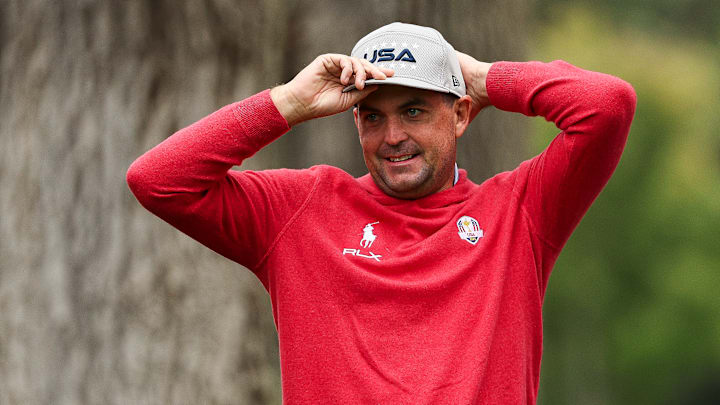Keegan Bradley is doing something that was long overdue—saluting Larry Nelson, whose Ryder Cup record in the first two competitions he played was 9-0-0. Bradley also hopes it will stand as an example for this year's U.S. team, and there’s a good reason for that.
Nelson, who will serve as an ambassador to Keegan's squad later this month, took down Spanish legend Seve Ballesteros four times in the 1979 Ryder Cup matches and three times in the 1981 matches. He did that after serving in a tour of duty in Vietnam with the U.S. Army.
“When you talk to Larry Nelson about this stuff, he's such a humble guy, and you want more stories,” Bradley said. “I really feel it's our duty to honor people like him, honor great Americans on our Ryder Cup team.”
The U.S. has had all manner of heroes in golf, starting with Bobby Jones and Walter Hagen in the 1920s and extending to the days of Ben Hogan and Byron Nelson and then on to Arnold Palmer and Jack Nicklaus and further to Lee Trevino and Tom Watson.
But in Europe, Ballesteros is the yardstick by which many measure their performance. For years, he was the heart and soul of Europe’s team. They revere his talent and passion, even though he does not have the best Ryder Cup record, nor the most tournament victories in Europe. The first belongs to Sergio Garcia and the latter to Sir Nick Faldo.
As a result, Ballesteros and his memory have become a talisman for Europe when it comes to the Ryder Cup because he won 50 tournaments in 20 years. He exuded confidence and made it contagious.
September of 1979 was the first Ryder Cup for both Nelson and Ballesteros.
That summer, Ballesteros won his first British Open, beating Jack Nicklaus and Ben Crenshaw. He was an absolute phenom.
By 1979, Nelson had won two PGA Tour events, the Jackie Gleason Inverrary Classic and the Western Open. No one considered him either a phenom or particularly impressive.
While Ballesteros was gifted with great talent and many flashy shots, Nelson was less flamboyant, more solid. In what had to be a shock at the time, at the Ryder Cup, Nelson and his partners were the ones who prevailed, beating the Spaniard four times that week.
Paired with Lanny Wadkins in morning fourball (best ball) on day one, the duo was victorious. They followed up by partnering again in the afternoon in alternate shot where they were also the winners.
“Hearing the stories from him and Lanny Wadkins and hearing about these old Ryder Cups and just knowing about his service to the country and his incredible Ryder Cup record, and then to top it off of like what an amazing human being he is, it's more of an asset for us to have him around,” Bradley added about Nelson.
On day two, the Nelson and Wadkins again played Ballesteros and Antonio Garrido, and won both formats of golf again. Nelson and Wadkins were 4-0-0.
Then, on Sunday in singles, Nelson drew Ballesteros and defeated him 3&2, achieving a 5-0-0 record for the 1979 matches. Not many players have gone 5-0-0 in the history of the Ryder Cup. If anyone has gone 5-0-0 in Ryder Cup against Ballesteros, let him raise his hand. It’s doubtful that it happened.
Nelson was off to a good start, and in the 1981 Ryder Cup at The Greenbrier, he did not disappoint. That year, he was 4-0, teamed up with Lee Trevino once and Tom Kite twice for victories and then winning his singles match. He made the team by winning the PGA Championship that season. In a strange move, Ballesteros did not play due to a disagreement with the European Tour. Seve being Seve.
Nelson’s last Ryder Cup appearance in 1987 was tarnished somewhat by the emergence of what can only be described as the Big Five, the royal flush of European golfers: Ballesteros, Sir Nick Faldo, Bernhard Langer, Ian Woosnam, and newcomer Jose Maria Olazabal, who replaced stalwart Sandy Lyle.
Olazabal had never played in the Ryder Cup before and surely was nervous. In a Columbus Dispatch story, it was reported that Ballesteros calmed him by saying something along the lines of, "You play your own game, and I’ll take care of the rest". And Seve did.
The defeat at Muirfield Village GC became the first time Europe had won the event in the U.S. in 40 years and only the fifth time they won since the matches began in 1927. They were euphoric.
Since that time, particularly because of the addition of European players to what had been Great Britain and Ireland, the talent level has been more evenly matched, and the pendulum seems to have swung the other way. Since 1987, it has been 10 to 6, Europe, with one tie. Part of that is due to the Euro strategy of the Big Five, as they were to be called.
The big five were formidable. Their strategy was to have each of the five play nearly every match. The Europeans were betting that they could get a big advantage on the first two days with those five players. And often they did. Sometimes players on their teams did not see action until Sunday. That’s when they would have to take their chances.
In two weeks, it unfolds again, this time at Bethpage Black, which New Yorkers regard as a rather sacred space to play public golf. It will be boisterous. It will be contentious. It will be loud. It will be amazing.
